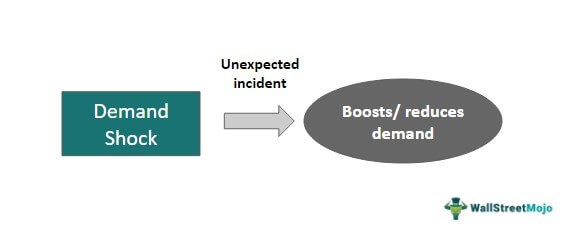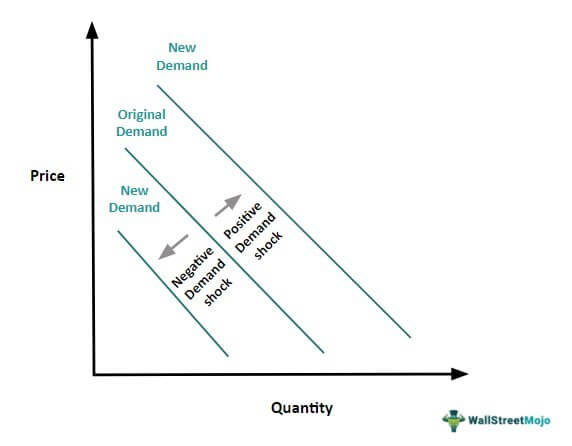What Is Demand Shock?
A demand shock is an unexpected incident that temporarily boosts or reduces demand for products or services. It’s positive value drives up aggregate demand, while it’s negative value drives down aggregate demand.

You are free to use this image on your website, templates, etc, Please provide us with an attribution linkHow to Provide Attribution?Article Link to be Hyperlinked
For eg:
Source: Demand Shock (wallstreetmojo.com)
This term comes from the field of economics. For example, a demand shock can alter customers’ capacity or desire to acquire products and services at prices. This can happen either because of an increase in prices, policy change, or any unforeseen event.
Table of contents
Key Takeaways
- A demand shock is a phenomenon that causes a brief rise or fall in aggregate demand from its normal level. It can be positive or negative.
- A demand shock in the positive direction will result in a shortage, pushing the price, while a negative direction will lead to an oversupply and a price decrease.
- The duration of a demand shock might range anywhere from just a few days to several weeks, but they can sometimes have far-reaching effects.
- How prices of transactions, quantities provided, and quantities consumed fluctuate will mirror the direction in which aggregate demand moves.
Demand Shock Explained
Demand shock is a rapid and transient surge or reduction in the demand for a product or collection of products. The term is most frequently used for cumulative demand, defined as the total demand for a whole economy.
A supply shock is a rapid change in the market supply or service that creates a visible effect on the economy, as opposed to a demand shock, which is a sudden change in the demand for a product or service. A couple of instances of economic shifts include changes in supply and demand. Both shocks will have an impact on the prices of the item or service that is being offered.
An abrupt occurrence that causes a shift in perception and demand causes a demand shock. This unforeseen occurrence causes a big but temporary disruption in the selling price of an item or service.
It also can be caused by several different things, including an earthquake, an act of terrorism, a technical advancement, or a fiscal stimulus program. An unfavorable report, a defective product, or an unexpected occurrence in the news can also do this.
Financial Modeling & Valuation Courses Bundle (25+ Hours Video Series)
–>> If you want to learn Financial Modeling & Valuation professionally , then do check this Financial Modeling & Valuation Course Bundle (25+ hours of video tutorials with step by step McDonald’s Financial Model). Unlock the art of financial modeling and valuation with a comprehensive course covering McDonald’s forecast methodologies, advanced valuation techniques, and financial statements.
Example
A video interview posted by Yahoo Finance discusses how the demand shock in the United states pressurizes other central banks. It is discussed that monetary authorities across the globe are currently contending with supply and demand variations, respectively. And if one has a negative supply shock that’s putting up prices, the way to address a supply shock is not always by fighting it with higher interest rates. This is because the negative supply shock is setting up prices. It is in the best interest to make room for it, given that the increase in the price of commodities will likely reduce demand in the foreseeable future.
If the sudden change was caused by demand, one must act to remedy it. There is a very evident and far more noticeable demand-led shock in the United States. There is a variation in the market’s supply and demand sides. Because of this, the Federal Reserve is now at the front of this movement. However, this undoubtedly puts significant pressure on these other central banks.
Graph
A demand shock can graphically represent a movement throughout the demand curve. Alternatively, it can be said that the shock increases or reduces the quantity sought at any given price.

You are free to use this image on your website, templates, etc, Please provide us with an attribution linkHow to Provide Attribution?Article Link to be Hyperlinked
For eg:
Source: Demand Shock (wallstreetmojo.com)
The price of an item or service will often go up whenever demand for that commodity or service grows quickly because providers cannot keep up with the rising demand. This causes a shift to the right on the demand curve, which, in economic terms, results in higher prices. The reverse effect is caused when there is an abrupt decline in demand. The current supply is far greater than the demand that is in existence.
A fiscal policy can create a positive shock, such as an economic stimulus or tax cut. Conversely, contractionary policies, such as reducing government spending or increasing interest rates, can result in a negative demand shock. Other contractionary policies include reducing the money supply.
Demand Shock vs Supply Shock
- A demand shock happens when there is an unforeseen shift in demand, so providers cannot react quickly enough to meet the new demand. In contrast, a supply shock occurs whenever there is an unanticipated shift in the amount of supply.
- A positive demand shock might increase the consumption of more items at a higher price, but a positive supply variation will result in a price decrease.
- Negative demand variations result in lower prices paid by consumers for the commodity. In contrast, negative supply shocks result in higher prices consumers pay for goods due to a lack of supply.
Frequently Asked Questions (FAQs)
Aggregate demand shock is anything that lowers the demand for money, often known as the velocity of money. The government can execute policies that will either increase or decrease the velocity of money, often known as “skillfully manipulating the money supply,” to return aggregate demand to its normal level.
A rise in aggregate demand can be attributed to a positive shock. As can be seen in the graph below, the whole demand curve moves to the right. This is because a sudden increase in demand is the definition of a positive shock, whereas a demand reduction is the definition of a negative shock.
The Federal Reserve finds it simpler to cope with shocks to production caused by fluctuations in demand rather than supply because it can diminish or even reduce the effect of demand variations on production through its management of the money supply.
Recommended Articles
This has been a guide to What is Demand Shock. We explain the concept in detail with an example, a graph, and a comparison with a supply shock. You may also find some useful articles here –


Am impressed